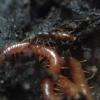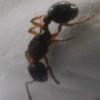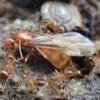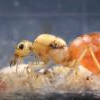1. Location (on a map) of collection: Marion, Indiana
2. Date of collection: 3/28/18
3. Habitat of collection: Under a stone slab
4. Length (from head to gaster): 3-4mm
5. Color, hue, pattern and texture: Lightly colored legs and antenna, rough texture
6. Distinguishing characteristics: Small propodeal spines
7. Distinguishing behavior: ?
8. Nest description: Rich, loose soil underneath a stone slab
9. Nuptial flight time and date: Unknown, likely from last year
I suspect it to be Myrmecina americana.

1. Location (on a map) of collection: Marion, Indiana
2. Date of collection: 3/28/18
3. Habitat of collection: On an oak tree
4. Length (from head to gaster): 2mm worker and 3-4mm queen
5. Color, hue, pattern and texture: Mostly black
6. Distinguishing characteristics: Fairly slender, 2 clear petiole nodes, no visible spines with 10x magnification
7. Distinguishing behavior: Polygynous
8. Nest description: In between 2 pieces of bark
9. Nuptial flight time and date: Unknown




And 4 more shots:




Edited by AntsAreUs, March 30 2018 - 6:09 PM.
























